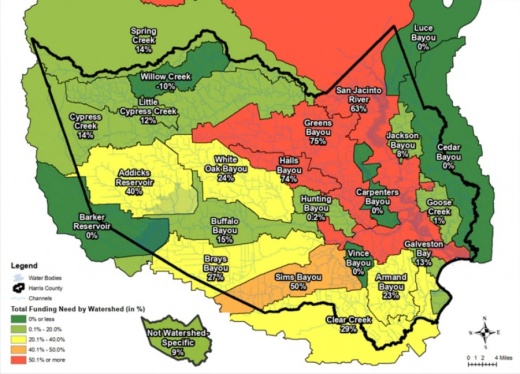New data presented March 9 by the Harris County Budget Office shows the three watersheds—Greens Bayou, Halls Bayou and the San Jacinto River watershed—are all less than 50% funded when it comes to the 2018 bond program passed by Harris County voters in Harvey's wake. In total, Halls Bayou has a funding need of about $272 million; Greens Bayou has a need of about $252 million; and the San Jacinto River watershed has a need of about $154 million. By comparison, six watersheds are 50%-80% funded; eight watersheds are between 81% and just under 100% funded; and another six watersheds are fully funded.
Greens Bayou and Halls Bayou contain communities that are among the most socially vulnerable in the county, according to 2018 data from the U.S. Centers for Disease Control and Prevention, and are also communities that see frequent flooding. During Harvey, an estimated 12,900 homes flooded in Greens Bayou, and 11,830 homes flooded in Halls Bayou—the third- and fourth-highest totals, respectively, among the county's 23 watersheds, according to data from the Harris County Flood Control District.
"This map here is like getting hit across the back with a baseball bat," Harris County Precinct 2 Commissioner Adrian Garcia said at the March 9 meeting where the data was presented. "Halls and Greens [bayous] are the two poorest watersheds in the county, and they’re basically left out of the process."
Stalled process
The data was included as a part of a larger discussion March 9 about the county's capital improvement plans over the next five years, including an update on the $2.5 billion flood-control bond referendum passed in 2018.
At the time, officials said $1.74 billion of that funding would be set aside for local use, while $872 million would be used to attempt to bring in another $2.5 billion in matching federal funds. At the March 9 meeting, Budget Chief Dave Berry said about $1.2 billion in federal funds has been secured so far, but another $1.4 billion remains in unmet needs.
The hitch in the plan can largely be tied to a shift in how federal officials with the U.S. Department of Housing and Urban Development decided to make funding available to the state, HCFCD Executive Director Russ Poppe said. Instead of giving the county a direct allocation of $1 billion in Harvey relief funding, HUD decided last January to send relief money to the Texas General Land Office to be made available in the form of competitive grants. The move was opposed by Houston and Harris County leaders at the time.
In October, the HCFCD submitted nine grant applications for a total of about $900 million, Poppe said. The HCFCD could hear back around late April or early May on awards, he said.
Because Community Development Block Grants given out by HUD historically favor neighborhoods that are more socially vulnerable, Poppe said the county planned on using that money on Halls and Greens bayous with some of it going to White Oak and Brays bayous as well.
The county is seeking $220 million in grant funding for Halls Bayou and $240 million for Greens Bayou, Poppe said. If the full amounts are awarded, he said it "would turn the red areas on the map to green." In the meantime, officials are using local funding to move forward with right of way acquisition, design and other elements of the planning process in those watersheds, Poppe said.
Harris County Judge Lina Hidalgo questioned why the district was relying on federal money for Halls and Greens bayous after explicitly putting aside $1.74 billion in bond funding for local use. She said the district should have planned for the possibility the $1 billion in direct federal funding would not come through.
"Frankly, this is not just a budget issue; this is a strategic issue," she said.
Waiting game
Commissioners unanimously approved a motion directing the HCFCD to work with the county's budget department on a plan that would describe how projects have been affected because of the stalled funding, how the county can prioritize existing resources to be more equitable and what the county will do if the state funding does not come through. The plan, due back to Commissioners Court on June 30, will also include a timeline for a potential second bond election for flood-control projects.
Precinct 1 Commissioner Rodney Ellis, whose precinct includes large portions of Halls and Greens bayous, said he was disappointed to see the watersheds that have historically been overlooked for flood-control funding are continuing to be underfunded. Prior to the 2018 bond election, commissioners made a point to include language in the ballot item specifically committing the county to "provide a process for the equitable expenditure of funds," which Ellis said was intended to prevent poorer watersheds such as Greens and Halls from being overlooked.
"We can pray for funding from federal partners; we can lobby for it, but if we don’t get it, it is unacceptable," Ellis said. "In my judgment, we will all have blood on our hands because we would have lied."
Ellis said he feared a second bond referendum would be rejected by voters, especially if the funding is focused on specific watersheds instead of on projects across the county.
Berry said the county could potentially find between $100 million to $500 million in funding from other county sources that could help partially fill the $1.4 billion flood-control shortfall as well. Commissioners discussed moving some surplus revenue from the Harris County Toll Road Authority to be used on street drainage projects or other projects that have a nexus of flood-control and toll road needs.
The county could also raise the HCFCD's tax rate, Berry said, but he warned raising the tax rate in a way that would meaningfully help with the shortfall would involve getting voter approval as well.
Because the county is still able to make progress on the bond projects while it waits to hear back on the grant applications, Poppe said he thinks the county has until the end of the year before more difficult decisions would have to be made in terms of what it should do with its available resources.
In the meantime, Garcia said constituents remain in harm's way.
"We’re fortunate that we have not had a major event like Harvey [since the bond]," he said. "[Tropical Storm] Imelda got real close."
The below charts show the total project costs for each watershed within the 2018 bond program and the funding need that remains for each watershed as of March.





